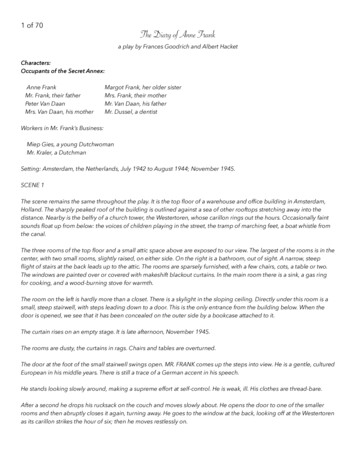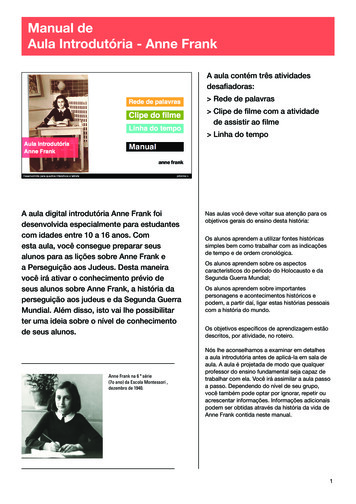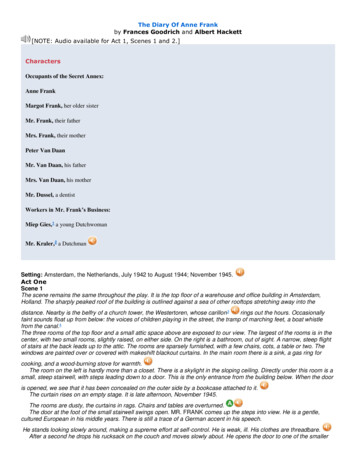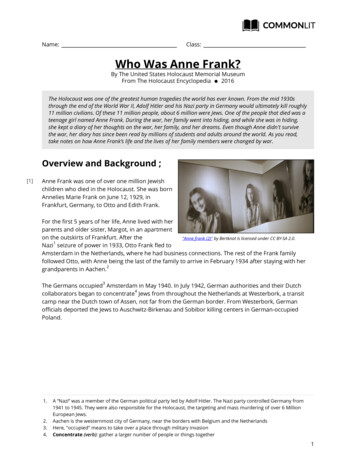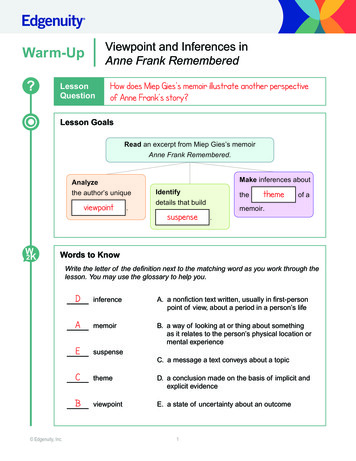
Transcription
Patient MonitorService Manual
SERVICE MANUALFor N5500 Patient MonitorTyco Healthcare15 Hampshire Street Mansfield, MA02048, U.S.A.Tyco Healthcare EMEA (Europe, Middle East and Africa)Tyco Healthcare UK Ltd. 154 Fareham Road, Gosport PO13 OAS, U.K.EU RepresentativeTyco Healthcare UK Ltd. 154 Fareham Road, Gosport PO13 OAS, U.K.Tel: (44) 1 329 224 114 Fax: (44) 1 329 224 390Manufactured for Tyco Healthcare Mansfield, MA 02048, U.S.A.Manufactured by Mediana Co.,Ltd. 231-6 Nonhyun-Dong, Kangnam-Ku, Seoul, KoreaCopyright 2003 Tyco Healthcare. All rights reserved.
NoticeThis document contains proprietary information which is protected by copyright. All Rights Reserved.Reproduction, adaptation, or translation without prior written permission is prohibited, except asallowed under the copyright laws.WarrantyThe information contained in this document is subject to change without notice.Tyco Healthcare makes no warranty of any kind with regard to this material, including, but not limitedto, the implied warranties or merchantability and fitness for a particular purpose.Tyco Healthcare shall not be liable for errors contained herein or for incidental or consequentialdamages in connection with the furnishing, performance, or use of this material.Revision/Printing HistoryThe documentation printing date and part number indicate its current edition. The printing date changeswhen a new edition is printed in accordance with the revision history of the documentation. Minorcorrections and updates which are incorporated at reprint do not cause the date to change. Thedocument part number changes when extensive technical changes are incorporated.
ContentsFiguresTablesIntroduction & MaintenanceIntroduction. 11.1 Manual Overview . 31.2 Related Documents. 31.3 Description of the N5500 Patient Monitor . 3Routine Maintenance . 72.1 Cleaning. 72.2 Periodic Safety and Functional Checks . 72.3 Functional Checks . 82.4 Batteries. 82.5 Environmental Protection . 8Performance VerificationPerformance Verification. 93.1 Introduction. 93.2 Equipment Needed. 93.3 Performance Tests.103.4 Safety Tests.23Default Settings & TroubleshootingService Menu and Factory Default Settings . 294.1 Introduction.294.2 Service Menu .294.3 Demo Mode .344.4 Factory Default Settings .34Troubleshooting. 375.1 Introduction.375.2 How to Use This Section .375.3 Who Should Perform Repairs .375.4 Replacement Level Supported .375.5 Troubleshooting Guide .38Disassembly Guide & Spare PartsDisassembly Guide . 456.1 General.456.2 Replacement Level Supported .476.3 Prior to Disassembly .476.4 Fuse Replacement.476.5 Battery Disassembly .496.6 Monitor Disassembly .506.7 Front Case Disassembly Procedures.516.8 Rear Case Disassembly Procedures.566.9 Optional Printer Assembly/Disassembly Procedures .65N5500 Service Manuali
ContentsSpare Parts . 677.1 Introduction .677.2 Obtaining Replacement Parts.677.3 Parts List.67Packing For Shipment . 718.1 General Instructions .718.2 Returning the N5500.718.3 Repacking In Original Carton .718.4 Repacking In a Different Carton .72Technical InformationSpecifications . 739.1 Display .739.2 Controls .739.3 Alarms .739.4 Physical.739.5 Electrical.749.6 Environmental Conditions .749.7 Measurement Parameters .759.8 Trends.779.9 Compliance.78System Processing Description. 8110.1 System Overview.8110.2 System Block Diagram.8110.3 ECG Processing .8710.4 NIBP Processing .8710.5 SpO2 Processing .8910.6 Respiration Processing .9110.7 Temperature Processing.92iiN5500 Service Manual
ContentsFiguresFigure 1. N5500 Front Panel.4Figure 2. N5500 Rear Panel.5Figure 3. N5500 Right Side Panel .6Figure 4. N5500 Left Side Panel.6Figure 5. The access of Service Menu via Set-up menu.29Figure 6. Service Menu.30Figure 7. Disassembly Sequence Flow Chart .46Figure 8. N5500 Exploded View .68Figure 9. N5500 System Block Diagram 1. 81Figure 10. N5500 System Block Diagram 2.82Figure 11. N5500 System Block Diagram 3.82Figure 12. Power Unit Block Diagram.83Figure 13. Process Unit Block Diagram.83Figure 14. User-Control Unit Block Diagram.83Figure 15. Sound Unit Block Diagram.84Figure 16. Communication Unit Block Diagram.84Figure 17. GUI Unit Block Diagram.84Figure 18. Thermal Printer Unit Block Diagram. 84Figure 19. NIBP Unit Block Diagram.85Figure 20. ECG Unit Block Diagram.85Figure 21. Respiration Unit Block Diagram.85Figure 22. SpO2 Unit Block Diagram.85Figure 23. Temperature Unit Block Diagram.86Figure 24. Analog Control Unit Block Diagram .86Figure 25. Oxyhemoglobin Dissociation Curve.90TablesTable 1. Required Test Equipments .9Table 2. Parameter Alarm Limit Factory Defaults .14Table 3. Earth Leakage Current Values .24Table 4. Enclosure Leakage Current.24Table 5. Patient Leakage Current Values .25Table 6. Patient Leakage Current Values - Mains Voltage on Applied Part .26Table 7. Test Lead Combinations .27Table 8. Allowable Leakage Current.27Table 9. Service menu .31Table 10. NIBP Test Mode.33Table 11. System Information.33Table 12. Factory Default Settings for the N5500 .34Table 13. Problem Categories.38Table 14. Power Problems .39Table 15. Display .40Table 16. Switches/Knob Problems.41Table 17. Alarms/Audible Tones Problems.41Table 18. Operational Performance Problems .42Table 19. Technical Error Codes.43Table 20. N5500 Parts List.69N5500 Service Manualiii
Section 1: IntroductionIntroduction andMaintenance, N55001.1 Manual Overview1.2 Related Documents1.3 Description of the N5500 Patient MonitorWarningsWarnings are identified by the WARNING symbol shown above.Warnings alert the user to potential serious outcomes (death, injury, or adverseevents) to the patient or user.WARNING: Explosion hazard. Do not use the N5500 in the presence offlammable anesthetics or gases.WARNING: Do not spray, pour, or spill any liquid on the N5500, its accessories,connectors, switches, or openings in the chassis.WARNING: Do not immerse the N5500 or its accessories in liquid or clean withcaustic or abrasive cleaners.WARNING: Ensure that conductive portions of the electrodes, leads, and cable donot come into contact with any other conductive parts.WARNING: Before attempting to open or disassemble the N5500, disconnect thepower cord from the N5500WARNING: The LCD panel contains toxic chemicals. Do not ingest chemicalsfrom a broken LCD panel.WARNING: The use of accessories, trans ducers, and cables other than thosespecified may result in increased emission and/or decreased immunity of theN5500 patient monitor.WARNING: Do not silence the N5500 audible alarm or decrease its volume ifpatient safety could be compromised.N5500 Service Manual1
Introduction andMaintenance, N5500IntroductionWARNING: During the safety test, AC mains voltage will be present on theapplied part terminals. Exercise caution to avoid electrical shock hazard.WARNING: Do not place the N5500 into operation after repair or maintenancehas been performed, until all Performance Tests and Safety Tests listed in section3 of this service manual have been performed. Failure to perform all tests couldresult in erroneous monitor readings.WARNING: High voltage is generated by the LCD backlight driver. Exe rcisecaution when operating monitor with covers open.CautionsCautions are identified by the Caution symbol shown above.Cautions alert the user to exercise care necessary for the safe and effective use ofthe N5500 monitor.CAUTION: Observe ESD (electrostatic discharge) precautions when workingwithin the unit and/or when disassembling and reassembling the N5500 patientmonitor and when handling any of the components of the N5500 patient monitor.CAUTION: When reassembling the N5500, over-tightening could strip out thescrew holes in the cases, rendering it unusable.CAUTION: If any problem with N5500 built in an optional printer, check aprinter’s door is closed well. Operating error may be caused if the cover is notclosed correctly.CAUTION: If internal battery cable has been disconnected, pay particularattention to polarity of the cable before reattaching. If battery cable polarity isreversed, it is likely that circuit damage will occur.CAUTION: Ferrite Cores are used for electromagnetic compatibility. Please donot remove Ferrite Cores while disassembling or reassembling, otherwise themonitor can be affected by electromagnetic interference and measure inaccuratedata to be displayed or stored.CAUTION: When reassembling, never forget that one of four screws on the backbracket must be connected to green ground cable of the power inlet. This methodis for protecting dormant electrical shock hazards to operator or service engineer.2N5500 Service Manual
IntroductionThis manual contains information for servicing the N5500 patient monitor.The monitor subsequently referred to as N5500 throughout this manual. Only qualifiedservice personnel should service this product. Before servicing the N5500, read theoperator’s manual carefully for a thorough understanding of safe operation.Read and understand all safety warnings and service notes printed in this servicemanual and the operator’s manual part number MDR05002-A7008.1.2 Related DocumentsTo perform test and troubleshooting procedures and to understand the principles ofoperation and circuit analysis sections of this manual, you must know how to operatethe monitor. Refer to the N5500 operator’s manual part number MDR05002-A7008.To understand the various Nellcor sensors, ECG leads, blood pressure cuffs, andtemperature probes that work with the monitor, refer to the individual directions foruse that accompany these accessories.1.3 Description of the N5500 Patient MonitorThe purpose and function of the Nellcor N5500 patient monitor is to monitor ECG,heart rate, noninvasive blood pressure (systolic, diastolic, and mean arterial pressures),functional arterial oxygen saturation, respiration, and temperature for adult, pediatricand neonate patients in all hospital areas and hospital- type facilities. It may be usedduring hospital transport and in mobile, land-based environments, such as ambulances,within the specification of the environmental characteristics. It is not intended for homeuse. Monitor users should be skilled at the level of qualified health care professionals,such as a technician, doctor, nurse or medical specialist.Note: Hospital use typically covers such areas as general care floors, operating rooms,special procedure areas, intensive and critical care areas, within the hospital plushospital-type facilities. Hospital-type facilities include physician office basedfacilities, sleep labs, skilled nursing facilities, surgicenters, and sub-acutecenters.Note: Intra-hospital transport includes transport of a patient within the hospital orhospital-type facility.N5500 Service Manual3Introduction andMaintenance, N55001.1 Manual Overview
Introduction andMaintenance, N5500IntroductionThe physical and operational characteristics of the monit or are described in theoperator’s manual and in the Specifications section of this manual.Figure 1 and 2 identify the displays, controls, indicators and symbols of the front andrear panels.2512HRECG/minECGSpO2 100(120)180(120)180Resp612012006/12/2002 08:12:23/minTT11TT229 10 11 12 13 14 15 161. Waveform Display Icon2. Graphic Frame3. Message Frame4. Set-up Icon5. Alarm/Limits Icon6. Big Numbers Icon7. NIBP Start/Stop Switch8. Power On/Off Icon9. Power On/Off Button10. Power On/Off Indicator11. Record Switch12. Battery Icon13. Patient Mode DisplayC2437.0F17 18 19 20 21 22 23 2414. Home Switch15. Date and Time Display16. Alarm Silence/Suspend Switch17. Knob Switch18. Low Battery Indicator19. Battery Charging/ AC Power Indicator20. Pulse Amplitude Indicator21. Numeric Value Display22. SatSeconds Indicator23. Numeric Frame24. Numeric Display Icon25. Alarm IndicatorFigure 1. N5500 Front Panel4N5500 Service Manual
IntroductionIntroduction andMaintenance, N5500121110 16V 5A10RS2322 XT 4.0A 250V1 2 3 45671. External DC Power Connector2. Equipotential Terminal (Ground)3. External DC Power Symbol4. Fuse Holder5. Fuse Replacement (Fuse Label)6. AC Power Connector897. Data Interface Symbol8. Data Port Connector9. Network Connector10. Network Symbol11. Product Label12. Heat SinkFigure 2. N5500 Rear PanelThe N5500 patient monitor has a color liquid crystal display (LCD). The Numericframes on the screen contain five numeric values are displayed. The Graphic Framescontain three equally sized graphic frames in which real-time physiological waveforms,graphical trend, or tabular trend data are displayed.Controlling is accomplished by using the knob to interact with the appropriate area oricon on the screen.N5500 Service Manual5
Introduction andMaintenance, N5500IntroductionT1T2SpO21212345345ECG/Respiration ConnectorSpO2 ConnectorNIBP ConnectorTemperature Connector (T2)Temperature Connector (T1)Figure 3. N5500 Right Side PanelM4014-011Optional thermal printer or Printer coverFigure 4. N5500 Left Side Panel6N5500 Service Manual
Section 2: Routine MaintenanceIntroduction andMaintenance, N55002.1 Cleaning2.2 Periodic Safety and Functional Checks2.3 Functional Checks2.4 Batteries2.5 Environmental ProtectionWARNING: Do not spray or pour any liquid on the monitor or its accessories. Donot immerse the N5500 or its accessories in liquid or clean with caustic orabrasive cleaners.2.1 CleaningTo clean the N5500, dampen a cloth with a commercial, nonabrasive cleaner and wipethe exterior surfaces lightly.CAUTION: Do not allow any liquids to come in contact with the power connectoror switches or to penetrate connectors or openings in the instrument.Note: For cables, sensors and cuffs, follow the cleaning instructions in the directionsfor use that accompany these accessories.Note: If liquid is spilled on the monitor, clean and dry thoroughly before reuse.Note: If in doubt about monitor safety, refer the unit to qualified service personnel.For surface-cleaning, follow your institution’s procedures or:lThe N5500 may be surface-cleaned by using a soft cloth dampened witheither a commercial, nonabrasive cleaner or a solution of 70% alcohol inwater, and lightly wiping the top, bottom, and front surfaces of the monitorlightly.2.2 Periodic Safety and Functional ChecksThe N5500 requires no routine service or calibration other than cleaning and batterymaintenance. The following performance verification tests may be used followingrepair or during routine maintenance (if required by your local institution).1. Inspect the exterior of the N5500 for damage.2. Inspect labels for legibility. If the labels are not legible, contact Nellcor TechnicalServices Department or your local Nellcor representative.3. Verify that the unit performs properly as described in Performance Verificationsection.N5500 Service Manual7
Introduction andMaintenance, N5500Routine Maintenance4. Perform the electrical safety tests detailed in Performance Verification section. Ifthe unit fails these electrical safety tests, do not attempt to repair. Contact NellcorTechnical Services Department or your local Nellcor representative.2.3 Functional ChecksThe following checks should be performed at least every 2 years by a qualified servicetechnician.1. If the monitor has been visibly damaged or subjected to mechanical shock (forexample, if dropped), perform the performance tests as described in PerformanceVerification section.2. Perform the electrical safety tests as described in Safety Tests section. If the unitfails these electrical safety tests, refer to Troubleshooting section.3. Inspect the fuses for proper value and rating (qty 2, 4.0 A, 250 volts).2.4 BatteriesIf the N5500 has not been used for a long period of time, the battery will need charging.To charge the battery, connect the N5500 to an AC outlet as described in Paragraph3.3.1 in this service manual or the Battery Operation section of the operator’s manual.Nellcor recommends replacing the instrument’s battery every 2 years. When the N5500is going to be stored for 2 months or more, it is recommended to remove the batteryprior to storage. To replace or remove the battery, refer to Disassembly Guide .Note: Storing the N5500 for a long period without charging the battery may degrade thebattery capacity. The battery may require a full charge/discharge cycle to restorenormal capacity. Nellcor recommends that the N5500’s sealed, Ni-MH batteriesbe replaced at 2-year intervals. Refer to Disassembly Guide Section.Note: The battery cannot be charged by an external DC power source.2.5 Environmental ProtectionFollow local governing ordinances and recycling plans regarding disposal or recyclingbatteries and other device components.8N5500 Service Manual
Section 3: Performance Verification3.1 Introduction3.2 Equipment Needed3.3 Performance Tests3.4 Safety Tests3.1 Introduction3.2 Equipment NeededTable 1 lists the equipment required for performance verification.T
To understand the various Nellcor sensors, ECG leads, blood pressure cuffs, and temperature probes that work with the monitor, refer to the individual directions for use that accompany these accessories. 1.3 Description of the N5500 Patient Monitor The purpose and function of the Nellcor N5500 patient monitor is to monitor ECG,
